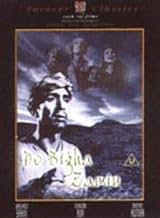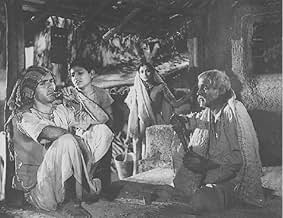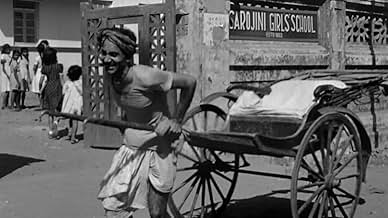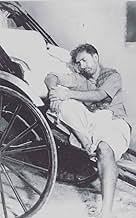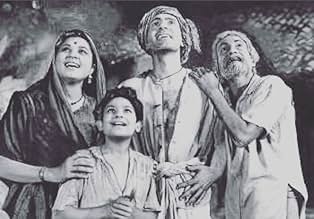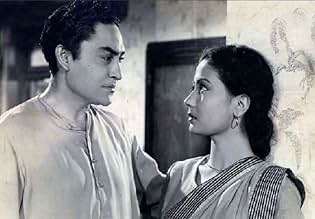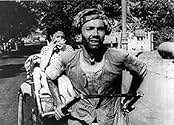IMDb-BEWERTUNG
8,3/10
2425
IHRE BEWERTUNG
Füge eine Handlung in deiner Sprache hinzuIn the hope of earning enough money to pay off his debts and save his land, a poor farmer becomes a rickshaw puller in Calcutta and faces many difficulties.In the hope of earning enough money to pay off his debts and save his land, a poor farmer becomes a rickshaw puller in Calcutta and faces many difficulties.In the hope of earning enough money to pay off his debts and save his land, a poor farmer becomes a rickshaw puller in Calcutta and faces many difficulties.
- Regie
- Drehbuch
- Hauptbesetzung
- Auszeichnungen
- 4 Gewinne & 2 Nominierungen insgesamt
Ratan Kumar
- Kanhaiya Maheto
- (as Rattan Kumar)
Rajlakshmi Devi
- Nayabji
- (as Rajlakshmi)
Nasir Hussain
- Rickshaw puller
- (as Nazir Hussain)
Ramayan Tiwari
- Paro's molester
- (as Tiwari)
Empfohlene Bewertungen
Made in 1953, with a socialist theme that was typical of many great bengali directors, this was a great film with superlative performances and very real feel to the film. Balraj Sahni, one of the five greatest actors of India ever, was simply stunning in this movie in terms of his natural acting and superior understanding of the life of a peasant first and then a novice rickshaw (two wheel cart pulled by a human, instead of the horse) puller fresh in the city (He naturally doesn't know that once u take a passenger to the destination, u have to hold it down so that the passenger can alight - he nervously waits for his first dime)..Ill have to come back and write more..sorry
Bicycle Thieves is a very touching Italian movie. But this one is our own native version of that. With genuine plot and out-of-the-world cinematography, Do Bigha Zamin is Indian masterpiece.
The actors are terrific, totally portraying the characters given to them. Music, direction, screenplay & the execution is all marvelous. Even today, this works because it talks about poverty, life, emotions, relationships & virtues. Fantastic. Moreover, the intricacy with which details are kept in focus should be the USP of this film. 9.1/10.
BOTTOM LINE: Get that DVD right now. A must-watch.
Can be watched with a typical Indian family? YES
Profanity: No | Sex/Nudity: No | Violence: Very Mild | Gore: No | Alcohol/Smoking: No | Drugs: Mild (Hookah)
The actors are terrific, totally portraying the characters given to them. Music, direction, screenplay & the execution is all marvelous. Even today, this works because it talks about poverty, life, emotions, relationships & virtues. Fantastic. Moreover, the intricacy with which details are kept in focus should be the USP of this film. 9.1/10.
BOTTOM LINE: Get that DVD right now. A must-watch.
Can be watched with a typical Indian family? YES
Profanity: No | Sex/Nudity: No | Violence: Very Mild | Gore: No | Alcohol/Smoking: No | Drugs: Mild (Hookah)
Bimalda's Do Bigha Zameen is considered a gem in Indian movies. The movie has a slight socialist theme as did most movies of that time. If the younger generation of Chinese, Eastern Europeans and Russians wonder why they saw so many Indian movies this socialist theme, probably is the answer. Do Bigha Zameen won the first ever Filmfare award. The movie got a special mention at the Cannes film festival. The movie is about a farmer Shambhu (Balraj Sahni), who has been hit badly by a famine in Bengal. The real reason of his sorrow is that the Zamindaar (land owner) wants to acquire his land on the pretext that Shambhu had taken some loan from him. Shambhu has to pay back and hence he moves to the city.
The movie paints a very true picture of pre-independence (and early post independence) India. The society is agrarian yet the farmers are poor mainly because of the fact that they have very small land holdings and they are unlettered. The farmers were gullible while the land owner, money lender and the Brahmins were guile. A lot of people moved to the cities either in the anticipation of turning there fortunes or because they could not survive the atrocities of power holders. The movie has a theme that can be found in works of notable Indian authors Munshi Premchand or Sarat Chandra Chaterjee.
The most memorable scene from the movie is when Shambhu pushes himself to his limits pulling a hand pulled rikshaw. The rider on the riksha offers Shambhu more and more money to pull faster because he is chasing (probably) his girlfriend in another rikshaw. Note Shambhu's emotions, his smile in anticipation of getting more. Compare this with the rich class which is not worried the least about the lower class' plight. The lower class is no more then a machine that can be operated by putting in quarters. The rikshaw looses a wheel and Shambhu is injured.
This is the kind of movie that can not be spoilt even if I were to write the entire story down for you. This is art not suspense thriller. You must watch this movie not for the story but the direction and the acting abilities of Balraj Sahni and Nirupa Roy (Shambhu's wife).
In all these hardships Shambhu does not loose his righteousness which is the moral of the movie. Shambhu's son steals money to help his father only to be reproached by his father. Shambhu's morality is the only thing that remains his own till the end.
The movie is notable for Balraj Sahni's performance and since it is another of Bimal Roy's movies you can expect only the best. Personally I recommend any of the Bimal Roy movies. Like other movies by him, art and commercial form of cinema are merged to produce a movie that is still looked upon as a benchmark.
Finally the name of the movie means Two Bigha of Land. Bigha is a unit of measuring land. Bigha varies from state to state. In Bengal where the movie is based 3 Bigha is one Acre. So Shambhu owns only 2.7 sq. kilometres.
The movie paints a very true picture of pre-independence (and early post independence) India. The society is agrarian yet the farmers are poor mainly because of the fact that they have very small land holdings and they are unlettered. The farmers were gullible while the land owner, money lender and the Brahmins were guile. A lot of people moved to the cities either in the anticipation of turning there fortunes or because they could not survive the atrocities of power holders. The movie has a theme that can be found in works of notable Indian authors Munshi Premchand or Sarat Chandra Chaterjee.
The most memorable scene from the movie is when Shambhu pushes himself to his limits pulling a hand pulled rikshaw. The rider on the riksha offers Shambhu more and more money to pull faster because he is chasing (probably) his girlfriend in another rikshaw. Note Shambhu's emotions, his smile in anticipation of getting more. Compare this with the rich class which is not worried the least about the lower class' plight. The lower class is no more then a machine that can be operated by putting in quarters. The rikshaw looses a wheel and Shambhu is injured.
This is the kind of movie that can not be spoilt even if I were to write the entire story down for you. This is art not suspense thriller. You must watch this movie not for the story but the direction and the acting abilities of Balraj Sahni and Nirupa Roy (Shambhu's wife).
In all these hardships Shambhu does not loose his righteousness which is the moral of the movie. Shambhu's son steals money to help his father only to be reproached by his father. Shambhu's morality is the only thing that remains his own till the end.
The movie is notable for Balraj Sahni's performance and since it is another of Bimal Roy's movies you can expect only the best. Personally I recommend any of the Bimal Roy movies. Like other movies by him, art and commercial form of cinema are merged to produce a movie that is still looked upon as a benchmark.
Finally the name of the movie means Two Bigha of Land. Bigha is a unit of measuring land. Bigha varies from state to state. In Bengal where the movie is based 3 Bigha is one Acre. So Shambhu owns only 2.7 sq. kilometres.
Post world war II, cinema was deeply influenced by the Italian realist wave. Rosselini and Visconti's hard hitting social commentary and De Sica's day-to-day struggle changed film-making like never before (or since). This wave gave birth to directors like Kurosawa, Fellini and Ray. One of the Indian masterpieces of those days was Bimal Roy's Do Bigha Zamin, which can arguably be termed as the Indian answer to De Sica's The Bicycle Thief.
This film has it's heart in the right place. The indivisible nature of the family, all of whose members work towards the fulfillment of a single objective, which is the fabric of Indian society, is the beauty of the film. All of the members- Shambhu, his wife, his father and son, intend to alleviate his situation and try to contribute in every way possible. The film ends in a sad satirical note, which is the principle characteristic of neo-realistic cinema.
Story apart, the most beautiful aspect of the film is the spirit with which on upholding of one's dignity and self esteem in the most perturbing situations. Though, the protagonist, Shambhu could have executed his task easily many ways, he opts for the most ethical choice of all- hard work. It is quite evident that Do Bhiga Zamin has been influenced by (and has influenced) cinema spanning different geographical, linguistic, and social backgrounds, but it still has a firm foot in its culture.
This film has it's heart in the right place. The indivisible nature of the family, all of whose members work towards the fulfillment of a single objective, which is the fabric of Indian society, is the beauty of the film. All of the members- Shambhu, his wife, his father and son, intend to alleviate his situation and try to contribute in every way possible. The film ends in a sad satirical note, which is the principle characteristic of neo-realistic cinema.
Story apart, the most beautiful aspect of the film is the spirit with which on upholding of one's dignity and self esteem in the most perturbing situations. Though, the protagonist, Shambhu could have executed his task easily many ways, he opts for the most ethical choice of all- hard work. It is quite evident that Do Bhiga Zamin has been influenced by (and has influenced) cinema spanning different geographical, linguistic, and social backgrounds, but it still has a firm foot in its culture.
This movie is a must see. It shows poverty with a humanistic approach in 1953 India. I went to Calcutta in 1999 and people still ride on human rickshaws (a person runs barefoot on streets while pulling the rickshaws for few cents). It is a very sad. It is heart breaking. In this movie get to see a common man problems and how he or she deals with it. It shows how corrupted the rich are and using the poor for their own means. This is how a 1/3 of India lives in today hi tech India. This is how people are suffering with all the economic boom India has. This is how people live in today's Independent and Free India. This movie is a must see.
Wusstest du schon
- WissenswertesWhen the shoeshine boys discuss seeing Nargis in Awara - Der Vagabund von Bombay (1951), one of them alludes to a shirt worn by a bystander. The shirt is decorated with a recurring pattern showing the famous scene from Awara - Der Vagabund von Bombay (1951) in which Raj Kapoor comes upon Nargis as she is changing clothes, partially hidden by a screen, after swimming. That scene occupies a place in Hindi cinema comparable to that of Deborah Kerr and Burt Lancaster on the beach in Verdammt in alle Ewigkeit (1953).
- Soundtrackshariyaala saawan dhol bajaata aaya
Sung by Lata Mangeshkar, Manna Dey
Top-Auswahl
Melde dich zum Bewerten an und greife auf die Watchlist für personalisierte Empfehlungen zu.
2025 Venice Film Festival Guide
2025 Venice Film Festival Guide
See the full lineup for the 2025 Venice Film Festival, taking place Aug. 27 – Sept. 9, 2025.
- How long is Do Bigha Zamin?Powered by Alexa
Details
- Laufzeit
- 2 Std. 11 Min.(131 min)
- Farbe
- Seitenverhältnis
- 1.37 : 1
Zu dieser Seite beitragen
Bearbeitung vorschlagen oder fehlenden Inhalt hinzufügen


